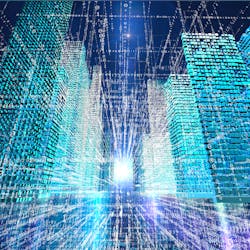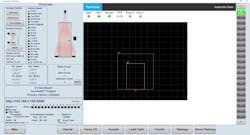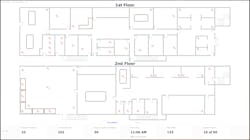This article originally appeared in the January 2023 issue of Security Business magazine. When sharing, don’t forget to mention Security Business magazine on LinkedIn and @SecBusinessMag on Twitter.
Keeping the wrong people out while letting the right people in seems simple enough, right? Yet, security has been plagued with how to handle this simple access control function for ages. As the world pivots from hardware to a software-centric approach to security, access control, building security and facility management have taken leaps in realizing what in the past we could only dream about – frictionless buildings that capture essential data and deliver that to the right parties in real time.
By leveraging sensors and technology like LiDAR, radar, point cloud and biometrics – combined with AI/machine learning and a single pane of glass management platform – end-users and systems integrators have full control over who is allowed in a building and where they can go within the building – all while providing valuable data based on patterns, anomalies, trends, etc. This makes a major positive impact for both security and operational efficiency, life safety and even business intelligence.
Let’s take a closer look at each of the technologies:
LiDAR
What makes LiDAR (Light Detection and Ranging, or Laser imaging, detection, and ranging) technology so ideal for access control is its ability to detect and ensure that every single individual passing an entry point has presented an authorized credential. LiDAR has gained attention for its ability to map out any surface in 3D, even for airborne and mobile applications, although the technology gained attentionRegarding security and access control, LiDAR, paired with other sensors and a data management system/platform, enables security professionals the ability to grant or deny access, track and identify people and objects, as well as infer things based on data being collected and analyzed (more to come on inference engines).
“Leveraging low-cost 3D sensor technologies, such as LiDAR and 3D cameras, empowers solutions for a variety of people-detection tasks including security and safety,” explains Danny Kent, Ph.D, president, co-founder and principle engineer at MechaSpin, where he leads a team that integrates new types of low-cost 3D sensors and AI into new products so customers can bring breakthrough capabilities and competitive advantages to market.
“As the need for accurate and anonymous spatial presence detection grows, 3D sensors such as LiDAR provide robust and low-cost solutions for a variety of security and safety applications,” he adds.
Inference Engines, Machine Learning and AI
As Dr. Kent points out, when paired with a powerful inference engine, an access and building control system can be taught over time using machine learning and neural network training, along with AI, enabling end-users and systems integrators to adapt and tailor an access control or building management system to meet specific needs and requirements.
“Combining AI with these technologies enables precise classification of objects such as people, animals, wheelchairs, carts and any other objects,” Kent notes. “Our machine intelligence engine provides 99% accuracy for classification and tracking of objects of interest, such as people and property. From people counting to human-machine safety, our approach provides robust, accurate and real-time spatial awareness with processing at the edge for a large variety of IOT tasks.”
It is truly amazing to see what we are finally able to do with all the data we can collect and process. As they say, knowledge is power, and being able to learn from and improve processes and procedures, even take a more preventative approach to security and operations, is now a reality.
“Being able to leverage LiDAR in combination with an inference engine affords us capabilities we could only imagine just a few years ago,” explains Mike Johnson, CPP ProFM, Enterprise Solutions at Orion Entrance Control, who has worked closely with Dr. Kent and Mechaspin to produce a powerful inference engine to power Orion’s DoorGuard tailgating solution. “The convergence of technology is truly expanding the reach of what’s possible and gives the end user the opportunity to collect essential data to solve expensive problems, such as eliminating the need to respond to false alarms.”
UWB Radar Technology
Radar technology is another powerful technology that is changing the way security views the interior spaces of a building, and, more importantly, the people occupying those spaces. Ultra-wideband, or UWB radar technology, captures micro- and macro-motions, and can even provide vital data on a person’s well-being, from set ranges to specific monitoring of vital signs, based on the need of the end user. Because research has advanced so greatly in the areas of sensor data collection, UWB radar can be used for identifying precise location,Within security, health and life safety, Xandar Kardian has helped to bring greater awareness to the many radar applications within a myriad of facilities, including public, federal, healthcare, business, etc.
“We do one thing really well – radar algorithms – processing 15 million radar signals/second, which reacts to micro-vibration patterns generated from our body to empower automation for healthcare, real-tech and security,” notes Mark Eklund, VP of Security Solutions for Xandar Kardian. “We view this technology as a ‘first of a kind’ to be placed in areas of facilities that no other technology has been able to monitor, until now.”
Eklund points out that applications are very pertinent for security, such as bathrooms, laboratories, prison cells, hospital beds, retirement homes, even the homeowner, each of which has demands for privacy and supported by law that will never accept a camera in these spaces.
UWB radar is ideally suited to security because it transmits exploratory signals with a much larger spectrum than conventional radars. And because the solution can be employed anywhere, behind a wall, a ceiling, a painting, or wherever you need it, it provides additional benefits, privacy and flexibility that cameras and video surveillance simply cannot.
“As a complement to existing layers of security, this new layer can now detect presence, count how many are in a room at a given time and monitor, on a one sensor to one person, their breathing and heart rate live without identification of the person without touching or connecting to that person,” Eklund adds. “This means total privacy with guidance and live alerting from this technology when bad things happen.”
Open Architecture
The open-architecture debate is important to address here because the security industry, albeit kicking and screaming at first, has wholeheartedly embraced a much more open approach to security that involves manufacturers partnering with each other, which in turn creates a more complete solution that is not bound by the limitations of a closed, or proprietary system.
As has been the case for many in the industry, including Orion, partnering with companies that share the same core values and provide high-quality, American-made products – as close to where you manufacture your products – has been key to overcoming the many challenges posed by COVID and strains on the supply chain.
In addition to enabling an end-user and systems integrator to be able to pick and choose the access control system and technologies and solutions that are best suited for their needs, an open architecture approach in a sense is “future proofing” for any new technologies that are introduced down the road. In addition, the system is ready when any technology needs to be integrated, such as biometrics, for example, which is growing in demand and popularity.
A more open approach allows an end user to be able to bring all the data being produced by this amazing new technology we have been discussing here in this article and bring into one platform to not only monitor and troubleshoot all systems, but also track and monitor people and spaces, providing a holistic approach to security that has been the missing piece for so long.
About the Author

Steve Caroselli
Steve Caroselli is Founder, President and CEO of Orion Entrance Control, a provider of turnstile and detection software solutions for security tailgating, occupancy sensing and presence detection. Request more info about the company at www.securityinfowatch.com/12106205.



